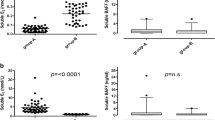Abstract
Purpose: To evaluate the percentages of macrophages present in granulosa cells (GC) cultures from patients with different responses to the hyperstimulation, in relation to the percentages of apoptotic cells (ApC), as well as to the release of cytokines.
Methods: We studied 42 patients: 12 Hyporesponders, (with ≤4 follicles), 15 Normoresponders, (5–14 follicles), and 15 Hyperresponders, (≥15 follicles). In GC cultures percentages of macrophages and ApC were counted and, in the conditioned media, cytokines were measured
Results: Percentages of macrophages were significantly higher in GC cultures from Hyporesponders compared with Hyperresponders patients. Also, the percentages of ApC cells were the highest in Hyporesponders. On the contrary, cytokines concentrations were the lowest in this group.
Conclusions: The low ovarian response is probably due to the decreased angiogenesis, which in turn produces increased apoptosis and decreased production of cytokines. The increased percentage of macrophages could be related to increased frequency of apoptotic cells.


Similar content being viewed by others
References
Takaya R, Fukaya T, Sasano H, Suzuki T, Tamura M, Yajima A. Macrophages in normal cycling human ovaries; immunohistochemical localization and characterization. Hum Reprod 1997;12:1508–12.
Kasuya K, Kawabuchi M. Macrophages are present not only in atretic mature follicles but also in the growing follicles of the guinea pig ovary. Ital J Anat Embryol 1998;103:183–9.
Wu R, Van Der Hoek KH, Ryan NK, Norman RJ, Robker RL. Macrophage contributions to ovarian function. Hum Reprod Update 2004;10:119–33.
Balasch J, Guimera M, Martinez-Pasarell O, Ros J, Vanrell JA, Jimenez W. Adrenomedullin and vascular endothelial growth factor production by follicular fluid macrophages and granulosa cells. Hum Reprod 2004;19:808–14.
Brannstrom M, Wang L, Norman RJ. Ovulatory effect of interleukin-1 beta on the perfused rat ovary. Endocrinology 1993;132:399–404.
Vinatier D, Dufour P, Tordjeman-Rizzi N, Prolongeau JF, Depret-Moser S, Monnier JC. Immunological aspects of ovarian function: role of the cytokines. Eur J Obstet Gynecol Reprod Biol 1995;63:155–68.
Terranova PF, Rice VM. Review: cytokine involvement in ovarian processes. Am J Reprod Immunol 1997;37:50–63.
Chung KW, Ando M, Adashi EY. Periovulatory and interleukin (IL)-1-dependent regulation of IL-6 in the immature rat ovary: a specific IL-1 receptor-mediated eicosanoid-dependent effect. J Soc Gynecol Investig 2000;7:301–8.
Gaytan F, Morales C, Garcia-Pardo L, Reymundo C, Bellido C, Sanchez-Criado JE. Macrophages, cell proliferation, and cell death in the human menstrual corpus luteum. Biol Reprod 1998;59:417–25.
Kasuya K. [Elimination of apoptotic granulosa cells in atretic follicles: the role of macrophages and intact granulosa cells]. Kaibogaku Zasshi 2002;77:23–30.
Abrams JM, White K, Fessler LI, Steller H. Programmed cell death during Drosophila embryogenesis. Development 1993;117:29–43.
Savill J, Fadok V, Henson P, Haslett C. Phagocyte recognition of cells undergoing apoptosis. Immunol Today 1993;14:131–6.
Savill J, Dransfield I, Gregory C, Haslett C. A blast from the past: clearance of apoptotic cells regulates immune responses. Nat Rev Immunol 2002;2:965–75.
Davis JS, Rueda BR, Spanel-Borowski K. Microvascular endothelial cells of the corpus luteum. Reprod Biol Endocrinol 10-11-2003;1:89-.
Lee A, Christenson LK, Patton PE, Burry KA, Stouffer RL. Vascular endothelial growth factor production by human luteinized granulosa cells in vitro. Hum Reprod 1997;12:2756–61.
Neufeld G, Cohen T, Gengrinovitch S, Poltorak Z. Vascular endothelial growth factor (VEGF) and its receptors. FASEB J 1999;13:9–22.
Levitas E, Chamoun D, Udoff LC, Ando M, Resnick CE, Adashi EY. Periovulatory and interleukin-1 beta-dependent up-regulation of intraovarian vascular endothelial growth factor (VEGF) in the rat: potential role for VEGF in the promotion of periovulatory angiogenesis and vascular permeability. J Soc Gynecol Investig 2000;7:51–60.
Lebovic DI, Bentzien F, Chao VA, Garrett EN, Meng YG, Taylor RN. Induction of an angiogenic phenotype in endometriotic stromal cell cultures by interleukin-1beta. Mol Hum Reprod 2000;6:269–75.
Van Blerkom J, Antczak M, Schrader R. The developmental potential of the human oocyte is related to the dissolved oxygen content of follicular fluid: association with vascular endothelial growth factor levels and perifollicular blood flow characteristics. Hum Reprod 1997;12:1047–55.
Quintana R, Kopcow L, Sueldo C, Marconi G, Rueda NG, Baranao RI. Direct injection of vascular endothelial growth factor into the ovary of mice promotes follicular development. Fertil Steril 2004;82 Suppl 3:1101–1105.
Quintana R, Kopcow L, Marconi G, Sueldo C, Speranza G, Baranao RI. Relationship of ovarian stimulation response with vascular endothelial growth factor and degree of granulosa cell apoptosis. Hum Reprod 2001;16:1814–8.
Friedman CI, Danforth DR, Herbosa-Encarnacion C, Arbogast L, Alak BM, Seifer DB. Follicular fluid vascular endothelial growth factor concentrations are elevated in women of advanced reproductive age undergoing ovulation induction. Fertil Steril 1997;68:607–12.
Barroso G, Barrionuevo M, Rao P, Graham L, Danforth D, Huey S, Abuhamad A, Oehninger S. Vascular endothelial growth factor, nitric oxide, and leptin follicular fluid levels correlate negatively with embryo quality in IVF patients. Fertil Steril 1999;72:1024–6.
Doldi N, Bassan M, Fusi FM, Ferrari A. In controlled ovarian hyperstimulation, steroid production, oocyte retrieval, and pregnancy rate correlate with gene expression of vascular endothelial growth factor. J Assist Reprod Genet 1997;14:589–92.
Doldi N, Destefani A, Gessi A, Grossi D, Ferrari A. Human albumin enhances expression of vascular endothelial growth factor in cultured human luteinizing granulosa cells: importance in ovarian hyperstimulation syndrome. Hum Reprod 1999;14:1157–9.
Acknowledgements
This study was supported in part by the National Research Council of Argentina (CONICET).
Author information
Authors and Affiliations
Corresponding author
Rights and permissions
About this article
Cite this article
Barañao, R.I., Quintana, R., Martín, A. et al. Significance of ovarian macrophages in the follicular aspirates from ART patients. J Assist Reprod Genet 24, 137–142 (2007). https://doi.org/10.1007/s10815-006-9102-9
Received:
Accepted:
Published:
Issue Date:
DOI: https://doi.org/10.1007/s10815-006-9102-9




